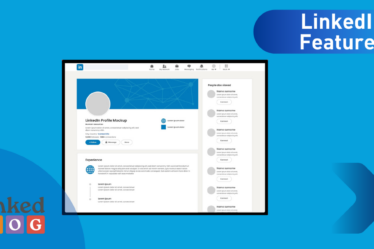
Seeking new strategies, implementing tools, and maneuvering with new ideas is the typical method used by many companies and people to achieve “the so wanted growth” of their business. But since we’re going at a fast pace applying those innovations, the business world is evolving, not daily, but hourly. Innovations are all there, tested and validated simultaneously, seen in all kinds of forms – technologies, systems or methodologies, etc.
Over the past 10 years, marketing as a strategy and management unit developed a lot. The communication channels are more number-wise than in the previous years. They’ve become more engaging, creative, and sociable. Some marketers debate whether social media could be considered a communication channel or just tools for it, but either way – they cannot deny the efficiency that it could bring to a business. Many famous companies have already implemented growth hacking tools and strategies on some of their social media, email strategies, and display advertisements but some of them still underestimate the power of one important professional channel – LinkedIn.
With this article, we’re willing to help them fill the growth hacking gaps so we will go through:
- What is “Growth Hacking”?
- The Growth Hacking Mindset
- Growth Hacking Skills
- “Tips” on how to put on use some strategies on LinkedIn
- Conclusion
Since the concept may be new to some of you, let’s start by quickly reviewing the “growth hacking” term and the concept behind it:
1. What is “Growth Hacking”?
The origin of the term came in 2010 by the inventor Sean Ellis. The word was used at that time in the startup field, because of the limited resources and budgets they usually have. “The Growth Hackers” are studying and testing new growth opportunities systematically in any part of the customer journey (from the stage of awareness through marketing to brand ambassadors) by optimizing the product or service regularly. Since then, many companies have used the term on different occasions, some of them even have their own “growth hacking” teams and departments (MixPanelTeam, 2022).
Many people confuse the role of the “growth hacker” with the role of the marketer in the business – at times, yes they can work on similar projects, but often their vision and build-up ways are different. The growth hackers usually are more focused on building future opportunities for the company, brand, and product, and the marketer is usually doing their day-to-day marketing and branding tasks.
2. The Growth Hacking Mindset
There are many factors that come to play when trying to create something new in the business. Sometimes the ideas come in as an experience, sometimes by following a certain pattern and sometimes… just based on a hunch. But to be successful, such a person has to have in the first place the mindset and working attitude, referred to specifically in this area as a “Growth Hacking Mindset”. Those people set their goals and where to implement them first, and after this, they think about the tool or technique that is needed for it. We may call it their “North Star Metric” but that is a complex topic for another time. That’s why it’s important for a growth hacker, or just a person looking to improve his business with growth hacking, to have a broad set of technical and soft skills, as well as knowledge. And LinkedIn has many opportunities for that (Ghislandi, 2021).
Expert growth hackers have found that three essential points are considered advantageous for them.
- Speed over perfection: Testing something as quickly as possible is better than starting something from scratch and building upon it. At least for the growth hackers – that makes sense. It can be compared to the saying “Less talking, more action”.
- Make data-based decisions: Of course, by using data and statistics analysis, you can positively boost your business effectively. After that, the questions “Where to spend resources?”, “What improvement would bring the best growth?”, etc. could be easily answered.
- Non-stop improvement: There is no need to say much here. If you’re willing to improve your business and self-person – learning, studying and testing constantly is the correct attitude to make overall growth.
3. Growth Hacking Skills
The interesting thing about the growth hackers is that they are independent, impulsive and quick in their decisions and actions. So yet again we go to the essential point of what skills should they have. We’ve taken out from our previous point that these experts make data-based decisions, and work with algorithms and statistics – so, therefore, knowing how to use specific programming tools and systems could be beneficial to them. Handling design tasks and thinking for strategic maneuvers is kind of necessary for them too since usually, that’s the innovative point of their job (Duggal, 2022).
Of course, there is no need for him or her to be an expert in everything, but since they’re doing a big chunk of the job by themselves – the more they know and can do would be the perfect scenario.
You can see in the picture some of the beneficial skills that the growth hackers are good to have on LinkedIn.
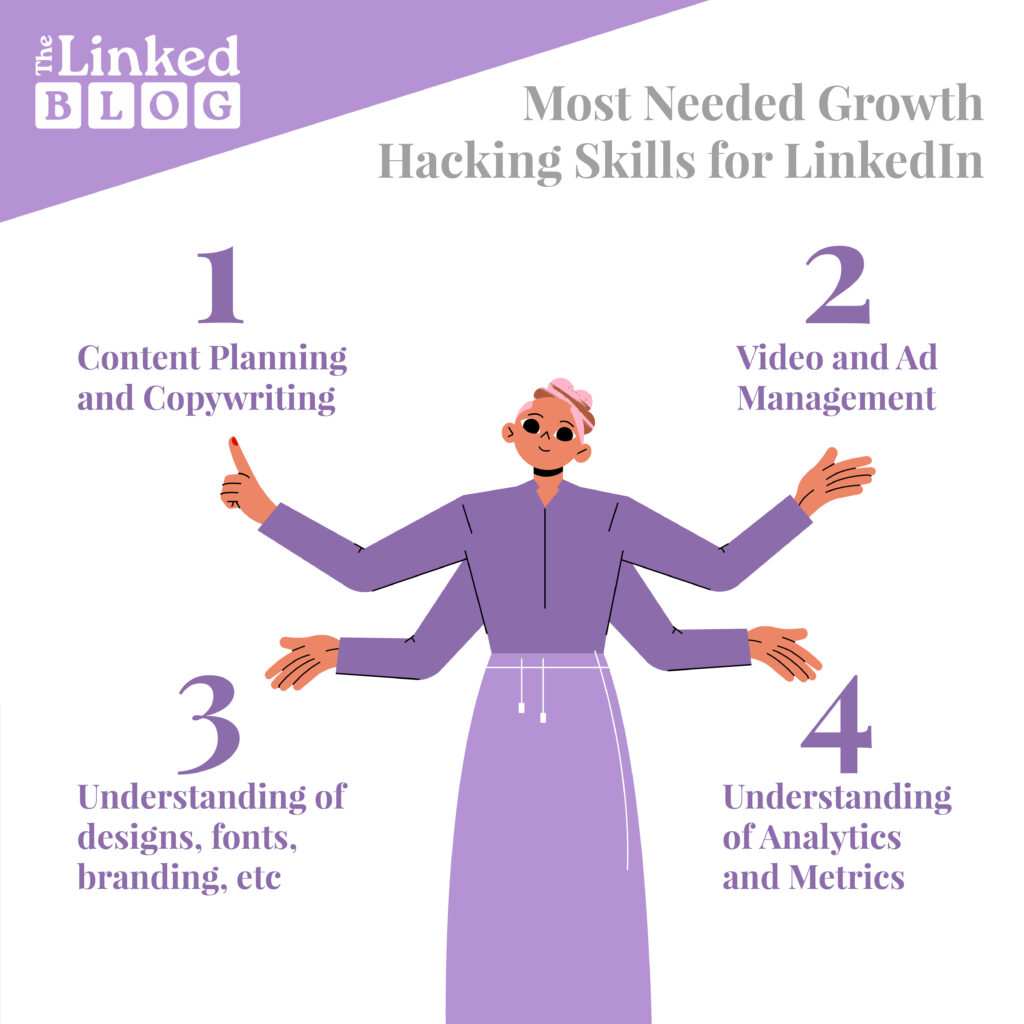
4. “Tips” on how to put on use some strategies on LinkedIn
For the past couple of years, the variety of social media channels and their opportunities attracted more and more growth hackers with the task of dissecting their positive sides, possibilities for business growth and specific content format. Many people tested some creative ideas and advertisement propositions on them. Yet many companies stick to one specific channel, whatever their type of business is – and that’s LinkedIn. Although LinkedIn is a very concentrated and well-niched social media, there are some practical growth hacking tricks that everyone could use to boost their engagement level.
One more thing before sharing those tips: have you wondered if you have ever made a publication/post that was well-written, and everything seemed fine in the copy part? Maybe even put on some emoji and links to boost the interest, but still, there was none or a little engagement on it.
- Pruning connections on LinkedIn – Let’s start by clarifying what’s the niche, industry, and type of business that we’re in. Since we don’t want to dilute our target, pruning is one option to return to the right track. The reason for this could be explained with an example – let’s say that we’re doing “Social Media Management” on LinkedIn – and we have 50% that are people who don’t know much about SMM or have no interest in that topic. That could conclude as 50% of people will not engage with any of our future content on the platform which will end up messing with the algorithms, and will stop showing the content to other people as well since it will think that is not relevant or simply not good enough. Of course, this may not be the case, as I’ve said earlier, the content could be informative and well written, but still may end up with bad results.
So with our tip to prune your connection – a target audience that you could do business with or an audience, that is in your industry and could be interested in your content. The practical thing to do is to use the “Filter Search” option on LinkedIn and fill it with the word that you want to have an association with within our case for example – “Social Media Management”. With those search results, you can either connect with people that are engaging with different articles, posts, etc, or just manually find active people there.- A bonus tip here is that posts with many comments are better than posts with many likes. The behavioral psychology behind this would say that those people are taking their time to write something under the publication, so therefore they’re feeling more engaged (actively reacting) to it, than simply liking (passively reacting).
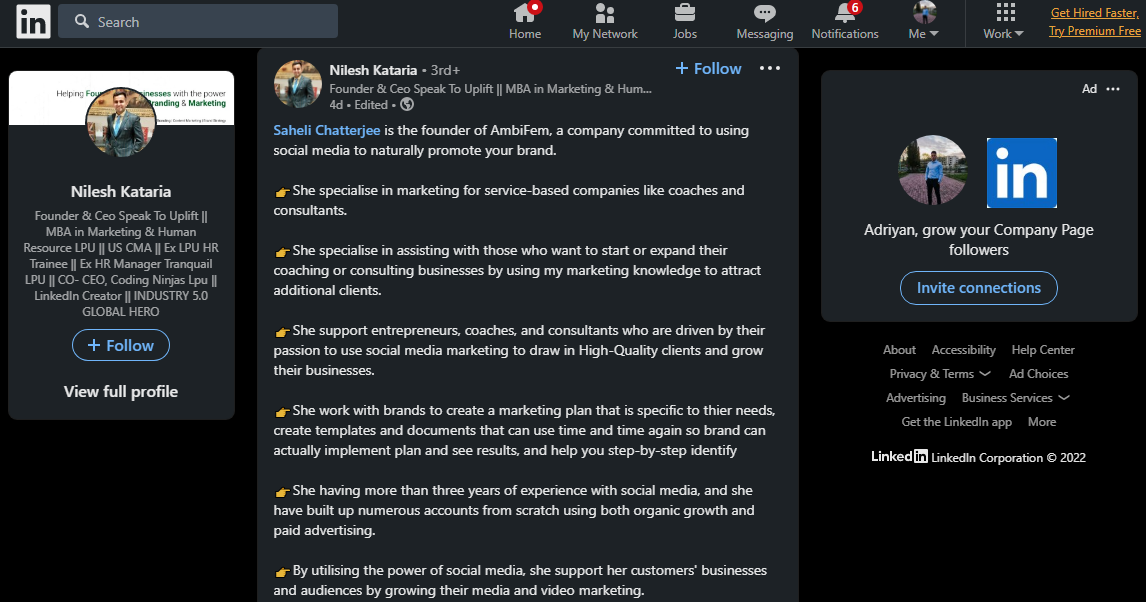
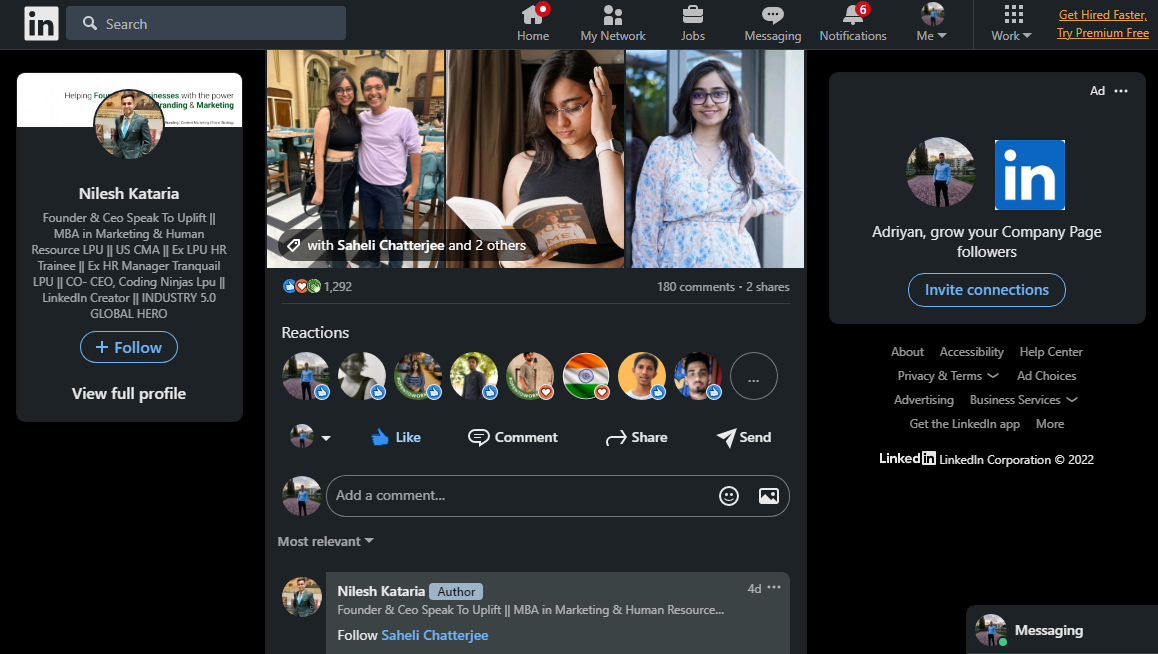
- Format of the content – The second tip is based on the format used for your posts. People are attracted more to visually appealing posts – some by infographics, others by simple-stylistic pictures, and third – by something different. LinkedIn is attractive to many professionals, so using formal formatting could be a good way to showcase your posts. After you consider carefully your target audience/industry – be aware of what they may like. To do that, you can try dry-runs (test runs) or A/B testings on your LinkedIn post concepts. That way you will find the right pattern to follow for your future creatives and the chance for your audience to engage with your content is more likely. Many creative tools could be used for that, but try to blend it well with the well-written text (Valyaeva, 2021).
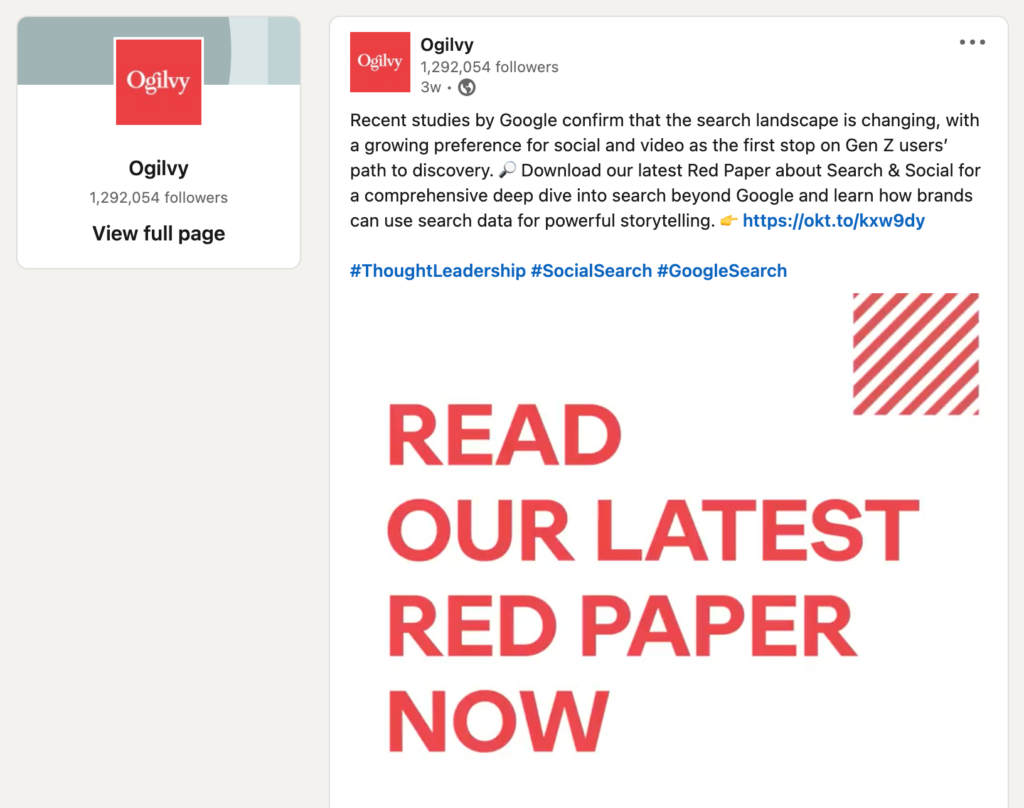
- Use storytelling – The last tip is to make use of your copy in the best possible way it could. You emphatically do not want to tell a beginning-to-end tale describing how results meet expectations. This is boring and a true red flag. Instead, you want to display the posts as a succinct and meaningful story. From a dynamic and catchy headline to finishing it with some tips or quotes, professional storytelling could make your profile look interesting and engaging to the audience. Just make sure to make a good all-around plan before posting something and always find a way to ask on-topic questions to your target persona (LiveCareer Staff Writer, 2014).
- Organic Search Growth – Another important growth that could be useful for your personal brand/business, could be to boost your organic growth on LinkedIn, as well. That could be connected with the idea to implement creative and efficient content, copywriting, and proper usage of words. So you may begin to expand your keywords list, do some testing with it and be brave. In the end – the most relevant and good content will win in organic search. Surely you will attract some movement from outside LinkedIn that could be beneficial.
- Hashtags and Emojis – Using proper hashtags is the next tip that we can advise you to think about. Quite a large number of people underestimate it and they lose the benefit that could be gained. Similar to organic growth in the search engine, the relevance of hashtags with the content you share is very important. Some hashtags are popular, others specific, and a third could be created by you – for a particular topic. With that, you can surely attract some audience towards you – potential connections, views, and probably sale opportunities. Just don’t overdo them – it could push back and backfire on you – stick to up to 5 hashtags per post.
- The power of the Links – If you have other social media channels besides LinkedIn – you have the potential to attract more audiences and be discovered by adding links to your profile (in articles, email signature, website footers, etc.). If your content is done outside LinkedIn and you want to share your content, you can implement that strategy in both your blog/website and LinkedIn post when sharing. With those links, you will be able to be linked to more websites and that becomes a huge plus for growth opportunities.
5. Conclusion
Growth Hacking is an innovative method, a modern trend that more and more companies are trying to follow. Its ultimate goal is always clear – to create growth in the company, but the way to achieve it is always different. As we understood from the article, to introduce such strategies in the company, marketers must have the attitude and mindset in order to become growth hackers. To do this successfully, it is good for the specialist or specialists to have a rich set of skills to use to implement such useful tactics. It is good to mix these skills with soft and hard ones because we realized that in this way the confident work of such specialists in the company is predisposed.
Last but not least, specifically for LinkedIn and how growth can be achieved there – we have found and clarified several useful tips. They’re including pruning connections, using the correct format for content and how to implement them in the best way for posts/ articles, and of course – how to put the power of storytelling to efficient use on your daily/weekly posting.


